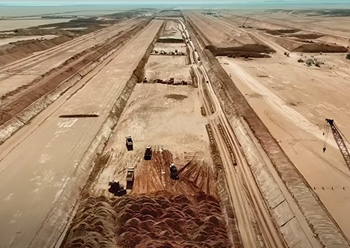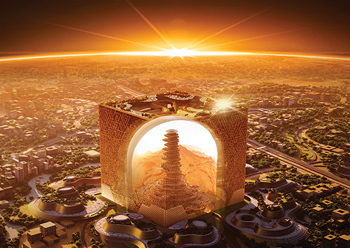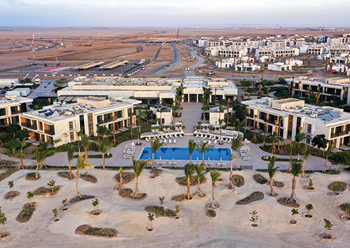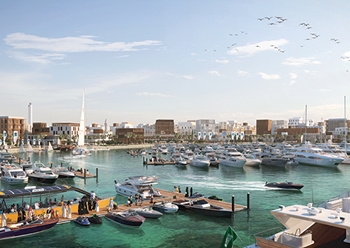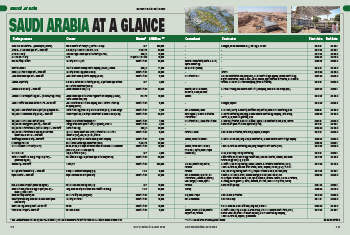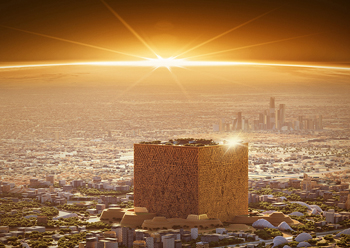
 As well as extensive sports facilities, the Sports Boulevard will create a modern oasis in Riyadh with 4.4 million sq m of greenery and open spaces.
As well as extensive sports facilities, the Sports Boulevard will create a modern oasis in Riyadh with 4.4 million sq m of greenery and open spaces.
Construction is well advanced on creating what is expected to be world’s largest urban linear park stretching over 135 km across Riyadh, which has been designed to enrich the life of the city’s residents through world-class sports facilities, entertainment and cultural offers, relaxing green spaces, public artworks and much more.
One of Saudi Vision 2030’s megaprojects, Sports Boulevard is an extensive and transformative project, which is expected to become a year-round destination for the people of Riyadh.
“We are proud to be creating what is expected to be the largest urban development project in the world, which will feature over 50 multidisciplinary sports facilities – offering residents the chance to get involved in a wide variety of sports, including cycling, running, hiking, skateboarding, sand volleyball and horse riding,” Jayne McGivern, CEO of Sports Boulevard Foundation, tells Gulf Construction in an exclusive interview. “By boosting participation in grassroots sports amongst people of all ages and abilities, we will improve health and wellness and encourage more people to lead an active lifestyle.”
“As well as access to over 50 sports facilities, residents will also be able to enjoy performances in our entertainment district, visit art exhibitions in our Arts District and have family days out in our playgrounds and parks,” she adds.
 |
|
McGivern ... fantastic progress. |
The Sports Boulevard extends over 135 km across Riyadh, connecting Hanifah valley in the West with Al Salai Valley in the East via the Prince Mohammed bin Salman bin Abdulaziz Road using exciting districts and facilities to encourage the city’s residents to follow a healthy lifestyle. It will stretch over eight different districts and will maximise the unique features and landscapes that Riyadh has to offer, McGivern says.
“For example, the sandy region southeast of King Khalid International Airport will become home to the Sports Sands Park District, which will feature a series of sandy and mountainous bike trails, a track for horse riders, pedestrian pathways, and more,” McGivern explains.
Other districts include the Athletics District, which will feature fields and training halls, and the Entertainment District, where Riyadh’s residents can enjoy performances in the amphitheatre and other entertainment spaces, as well as hillside playgrounds and parks, and open spaces.
As well as extensive sports and cultural facilities, the Sports Boulevard will create a modern oasis in Riyadh with 4.4 million sq m of greenery and open spaces, providing residents with access to safe outdoor areas while boosting the per capita share of green space by 62 per cent.
 |
|
Some 33 concrete columns have been erected for the cycling bridge. |
The project has involved a radical redesign of the city and every aspect of the Sports Boulevard has been designed to enrich residents’ health and wellbeing and ensure that Riyadh becomes one of the world’s most liveable cities. Hence, the Sports Boulevard Foundation introduced the Design Code in July 2022, to enhance the urban landscape through the creation of modern designs that highlight Riyadh’s distinctive local identity, driven by the principles of Salmani architecture.
The Sports Boulevard is one of Riyadh’s four ambitious projects, launched by the Custodian of the Two Holy Mosques King Salman bin Abdulaziz on March 2019. The Sports Boulevard Foundation was established in February 2020 to spearhead the project, which is being carried out in phases.
Work is currently in progress on the first phase, which covers four main areas:
• The second section of the Wadi Hanifah District, which stretches 22 km;
• The 900-m Cycling Bridge, through Prince Mohammed bin Salman Road;
• The Promenade area, which is 1.5 km in length;
• Prince Turki bin Abdulaziz Al-Awwal Road underpass with Prince Mohammad bin Salman Road.
In October 2021, the Sports Boulevard Foundation awarded contracts worth SR2.482 billion ($661.5 million) to several Saudi national firms for the construction of roads, bridges, and infrastructure at the Wadi Hanifah and the Art District, and the Cycling Bridge and Promenade.
The awarding of these contracts aimed to generate additional public and private sector investment through the allocation of 2.3 million sq km of land to showcase the potential of the project and its assets, McGivern points out.
Wadi Hanifah District will cover 29.5 km from Al Madina Al Munawwarah Road to Al Olab Dam. This district will feature pedestrian paths, horse-riding trails and routes for professional and amateur cyclists, as well as seven stations for cyclists with rest areas and maintenance centres, and various investment zones.
Commenting on the progress being made on the project, McGivern says: “We’re making significant progress in bringing this fantastic project to life, and work is already under way on the Cycling Bridge and Promenade and the Wadi Hanifah District.
“We’ve already constructed 33 concrete columns for the cycling bridge, and we’re fabricating the metal structures required for the bridge. We’re also preparing Wadi Hanifah for the natural earth layer and the base layer.
“We have already excavated over 250,000 cu m of soil works – the equivalent of 100 Olympic-sized swimming pools. This includes 30,000 cu m for concrete base works and 125,000 cu m for Prince Turki bin Abdulaziz Al-Awwal Road underpass.”
Given the magnitude of the Sports Boulevard, there have been a number of challenges to overcome, particularly as this project stretches over 135 km across Riyadh, connecting the city from East to West. Another challenge was presented by Riyadh’s surging population – which has risen from 400,000 in 1970 to over 8.6 million today.
“Given its city-wide scope, we’ve faced various challenges with managing existing utilities and cables, including the existing 132 kV and 380 kV buried high-voltage cables that run along the Prince Mohammad bin Salman Road. To mitigate the risk of existing utilities and cables clashing with the Sports Boulevard’s infrastructure, we arranged for our contractors to carry out a site survey to detect and tag the existing utilities serving adjacent residential neighbourhoods.
“The increasing population has created more demand for utilities, putting pressure on existing facilities. Effectively managing the utilities, existing and new, is one of the biggest hurdles for us to overcome, as is creating a vibrant public realm for the city’s growing population.
“The construction works will also have an impact on the city’s traffic. To counter this, we have made a key effort to identify suitable detours to minimise congestion and maintain the flow of traffic,” she elaborates.
So what are the tenders that can be anticipated? “We’re continuing to explore future contracts for the Sports Boulevard and these will be announced regularly,” McGivern says.
Sports Boulevard Foundation aims to complete this major project by 2027, with a range of phased openings between now and then. The first publicly accessible elements – the Cycling Bridge and Promenade – are expected to open by the first quarter of 2024.
“We are proud to be creating what is expected to be the largest urban development project in the world. The Sports Boulevard will create a positive impact across every section of Riyadh’s social fabric, including establishing a lasting economic influence through the creation of jobs, businesses, and heightened economic activity. Fantastic progress is already taking place, and we can’t wait to see first-hand the benefits that the Boulevard will bring to the whole of Riyadh,” McGivern concludes.

















.jpg)













 (1).jpg)














































